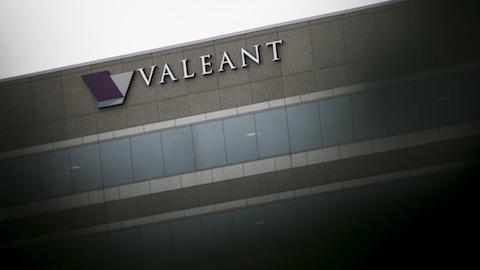A drug used to treat lead poisoning is causing a toxic reaction among hospitals and poison control centers after Valeant Pharmaceuticals jacked up the price more than 2,700 percent in a single year.
At issue is a decades-old, intravenous treatment for severe and life-threatening cases of lead poisoning, which occur infrequently, but generally require supplies to be on hand. Known as Calcium EDTA, Valeant acquired the drug in 2013 as part of a $2.6 billion deal to buy another company called Medicis.
After resolving manufacturing problems that caused shortages, Valeant pursued the hallmark strategy that made it infamous — taking sky-high price hikes. Before Valeant took control, the list price for a package of vials had been stable at $950. But in January 2014, Valeant boosted the price to $7,116. By December 2014, several more increases took the price to $26,927, according to Truven Health Analytics.
Ever since, poison control specialists have been angry, especially since there are few viable options and a French company sells its version for less. Their reaction is a case study in the exasperation doctors and hospitals feel at the multitude of price hikes of all sizes that they see month after month, the vast majority of which never make headlines but create frustration and squeeze budgets behind the scenes.
“This is a drug that has long been a standard of care, and until recently it was widely accessible at an affordable price,” said Dr. Michael Kosnett, an associate clinical professor in the division of clinical pharmacology and toxicology at the University of Colorado’s School of Medicine and a consultant to the California Poison Control System, who has contacted Congress. “There’s no justification for the astronomical price increases by Valeant, which limit availability of the drug to children with life-threatening lead poisoning.”
If this sounds like a familiar complaint, it is.
Valeant avoids double-digit price hikes with 9.9 percent increases
For nearly two years, Valeant has been a poster child for pharmaceutical greed. Before a series of congressional hearings and an accounting scandal altered its playbook, the drug maker regularly bought companies and then boosted prices on some medicines to new heights. The plan, which largely eschewed investment in R&D, made the company a Wall Street darling.
More recently, however, Valeant suffered the proverbial reversal of fortunes. Its strategy has been discredited, its stock price plunged, government investigations are piling up and a new management team was hired. As a gesture toward the company’s many critics, the new Chief Executive, Joe Papa, promised to eschew the sort of price hikes that were taken in the past.
But skepticism remains. The drug maker committed to offer discounts on a pair of heart drugs, which are used by hospital emergency rooms, after raising prices tremendously last year. But some hospitals still grumble they have not seen the discounts. And wary of scrutiny over double-digit price hikes, Valeant last month tried flying under the radar by raising the cost of three drugs by 9.9 percent.
A Valeant spokesman maintains the current pricing is justified. “The list price increases over the past several years have enabled us to provide to the market consistent availability of a product with high carrying costs and very limited purchase volume of 200 to 300 units per year,” he wrote us. Each unit contains a pack of five vials.
He added that Valeant must purchase sufficient supplies of needed ingredients in advance and this can amount to three to five times more than recent annual sales, which were between $3 million and $5 million last year. “Given [the drug’s] relatively limited shelf life, the company takes substantial carrying cost risk and has written down at its own expense approximately half of purchased quantities in the past few years,” he wrote, adding that list price does not reflect any rebates or discounts that Valeant pays.
And so, poison control specialists fear they are stuck with the current pricing. Prior to a congressional hearing held earlier this year on drug pricing, the California Poison Control System and the American Association of Poison Control Centers wrote to the House Committee on Oversight and Government Reform to investigate the price hikes, but nothing came of their efforts.
Doctors acknowledge that the relatively few cases of severe lead poisoning each year means that only a small number of packages are stocked. There were about 50 serious cases reported in 2015, according to the American Association of Poison Control Centers. But even this small outlay can take a toll on hospital finances and, by extension public health, according to emergency room experts.
“Lead poisoning is often an inner city problem and many hospitals don’t have a lot of resources in those areas,” said Dr. Lewis Nelson, who chairs the department of emergency medicine at Rutgers New Jersey Medical School. “Hospital pharmacy budgets are not unlimited, and this is the kind of drug nobody wants to keep around because there isn’t a lot of use. So this can create a dilemma.”
Moreover, hospitals and poison control centers apparently have few options.
A pill called DMSA may be used, but since people suffering from severe lead poisoning are unconscious or suffer seizures, it must be administered through a nasal tube into the stomach, which creates a risk of aspiration, Kosnett explained. And a hospital may be able to make a compounded version, but hospitals typically purchase intravenous medications and not all are equipped to make or sterilize such a drug.
“It’s not very viable or practical,” said Dr. Timur Durrani, an assistant clinical professor of medicine at the University of California, San Francisco and assistant medical director at the California Poison Control System. “It adds a level of complexity … Our hospital purchases the basic ingredients to compound the medication, but not all hospitals do … The price isn’t justified. Is Valeant doing something so magical that it takes thousands of dollars to make it sterile?”


Spread the word